“Agricultural experiments will be carried on in connection with the college farm and garden to such an extent as may be necessary for the requirement of instruction, and the means at command.”
-Alabama Agricultural and Mechanical College Catalog 1872-73
The founders of what would become Auburn University and the College of Agriculture were not about waiting. That’s why, several years before the formal establishment of an agricultural experiment station, they were already declaring the mission of such an institution and carrying it out, albeit with limited funds.
From a simple declaration in 1872, the Alabama Agricultural Experiment Station (AAES) has since grown into an interdisciplinary statewide organization that encompasses the work of almost 200 researchers in five colleges and at six interdisciplinary research centers and institutes located on the Auburn campus and at 15 outlying research units throughout the state.
“Our research operations continue today at sites across Alabama from the Gulf Shores to the Tennessee Valley to the Auburn University campus,” said Paul Patterson, dean of Auburn University’s College of Agriculture and director of the Alabama Agricultural Experiment Station. “Our research touches on every food and agricultural enterprise in Alabama, while seeking to preserve our important natural resources.”
The Experiment Station contributes to Auburn University’s land-grant mission of instruction, research and extension by seeking innovations and scientific discoveries that improve and protect the health and well-being of the citizens of Alabama, the nation and the world.
The AAES represents faculty and staff researchers from within five Auburn University colleges. Led by the College of Agriculture, others include the College of Human Sciences; College of Sciences & Mathematics; College of Forestry, Wildlife and Environment; and the College of Veterinary Medicine.
The AAES system of stations began in 1883 with the establishment of one station for research experiments in what is now the Agronomy Farm on campus. The Old Rotation and The Cullars Rotation were two of the early experiments to be initiated and continue today.
Today, the AAES maintains active research on 11 units. An additional two units, the Upper Coastal Plains Ag Research Center (Winfield) and the Piedmont Research Center (Camp Hill) are under Memorandum of Understanding with the College of Veterinarian Medicine and Forestry and Wildlife to operate and conduct research on sites owned by the AAES.
The AAES outlying units conduct approximately 600 experiments per year in every discipline of the College of Agriculture except fisheries and poultry science, which have centralized units close to campus. Total staffing currently stands at 100 employees across the state.
One person who has seen the work of the AAES literally from the ground up is Greg Pate, director of research operations for outlying units since 2021.
Pate previously served as director of the E.V. Smith Research Center, the largest, most visible and most comprehensive agricultural facility in the state with research units in beef cattle, horticulture, plant breeding, field crops and biosystems engineering.
Pate sees the mission of the research stations to provide the resources necessary for faculty and other investigators to address agricultural issues through highly controlled field experimentation.
“The staff on station apply science to farming in a way as to allow us to parcel out variability and obtain quality data so that researchers have a high degree of confidence in recommendations,” he said. “We also serve as the face of Auburn University, the AAES and the Alabama Cooperative Extension System to the public throughout the state through tours, workshops and field days.”
Pate has witnessed the introduction and implementation of mechanical technology to every element of production agriculture.
“Sprayers, planters, tractors, irrigation systems and harvest equipment all employ some level of technology to either control or monitor operations and applications. The level of precision with which applications are made, or environmental factors are monitored, is unprecedented in agriculture and offers more efficient control of valuable inputs and yield monitoring,” he said.
Biological technologies also continue to expand, offering resistance to herbicides, insects and disease. Environmental impacts of farming are greatly reduced by reducing pesticide and irrigation applications while helping producers find avenues for profitability.
As for the future of the AAES, the outlying units will continue to function as a critical part of the operations, Pate said.
“Even as science moves more and more towards genetic and biotechnological disciplines, there will still be a need to validate in the field through testing,” he said. “Also, as our general public population gets farther removed from the farm, there will be an increased need to invite them to the stations to see and learn for themselves the value of agriculture in Alabama.”
The AAES will continue to update technologies as dictated by trends in agriculture and look for ways to become more efficient within its own system, Pate said.
Outlying AAES outlying operations and units are organized into four regions—north, west-central, east-central and south. The stations in those regions have three main areas of focus that serve as the foundation for all the agricultural research conducted across all disciplines—cattle, row crops and horticulture.
The East-Central Region alone produced 157 research projects in 2023, representing all the main areas of focus, said Jane Farr, director of the region.
“The value of that research can be seen in our students—learning on station and taking that experience with them into a career,” Farr said. “The value also is seen in our researchers, unlocking a problem in a production system, finding a solution, sending that information out to our farmers, and, finally, standing shoulder to shoulder with local farmers and teaching them to use AAES technology to improve their operations. That is the value of our work in the AAES.”





